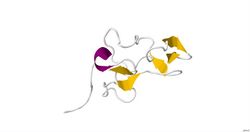Biology:Prokineticin
From HandWiki
| Prokineticin 1 | |
|---|---|
 Prokineticin 1[1] | |
| Identifiers | |
| Symbol | PROK1 |
| NCBI gene | 84432 |
| HGNC | 18454 |
| OMIM | 606233 |
| RefSeq | NM_032414 |
| UniProt | P58294 |
| Other data | |
| Locus | Chr. 1 p21 |
| prokineticin 2 | |
|---|---|
| Identifiers | |
| Symbol | PROK2 |
| NCBI gene | 60675 |
| HGNC | 18455 |
| OMIM | 607002 |
| RefSeq | NM_021935 |
| UniProt | Q9HC23 |
| Other data | |
| Locus | Chr. 3 p21.1 |
Prokineticin is a secreted protein that potently contracts gastrointestinal smooth muscle.[2]
Recently, prokineticins have been recognized in humans and other vertebrates.[3] They are thought to be involved in several important physiological processes like neurogenesis, tissue development, angiogenesis, and nociception.[3][4] Other important physiological roles the Bv8/Prokineticins (PKs) are involved in may include cancer, reproduction, and regulating physiological functions that influence circadian rhythms like hormone secretion, ingestive behaviors, and the sleep/wake cycle.[5]
Mutations in the PROK2 (also known as KAL4) gene have been implicated in hypogonadotropic hypogonadism and gynecomastia.[6]
See also
References
- ↑ "RCSB Protein Data Bank - Structure Summary for 2KRA - Solution structure of Bv8". http://www.rcsb.org/pdb/explore/explore.do?structureId=2KRA.
- ↑ "Identification of two prokineticin cDNAs: recombinant proteins potently contract gastrointestinal smooth muscle". Mol. Pharmacol. 59 (4): 692–8. 2001. doi:10.1124/mol.59.4.692. PMID 11259612.
- ↑ 3.0 3.1 "Chemical synthesis and structure of the prokineticin Bv8". ChemBioChem 11 (13): 1882–8. September 2010. doi:10.1002/cbic.201000330. PMID 20677202.
- ↑ Liu B, Qiao L, Liu K, Piccinni-Ash TJ, Chen ZF. Molecular and neural basis of pleasant touch sensation. Science 2022; 376(6592):483. doi:10.1126/science.abn2479
- ↑ "Bv8/Prokineticin proteins and their receptors". Life Sci. 81 (14): 1103–16. September 2007. doi:10.1016/j.lfs.2007.08.011. PMID 17881008.
- ↑ Narula, Harmeet S.; Carlson, Harold E. (2014). "Gynaecomastia—pathophysiology, diagnosis and treatment". Nature Reviews Endocrinology 10 (11): 684–698. doi:10.1038/nrendo.2014.139. ISSN 1759-5029. PMID 25112235.
External links
- PROK1+protein,+human at the US National Library of Medicine Medical Subject Headings (MeSH)
- PROK2+protein,+human at the US National Library of Medicine Medical Subject Headings (MeSH)
 |

